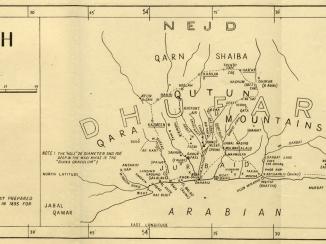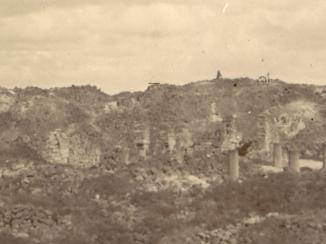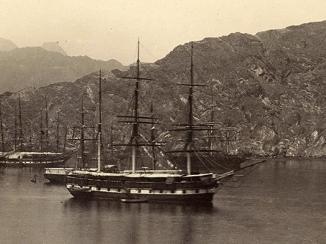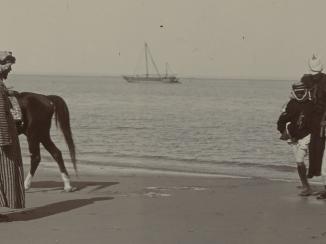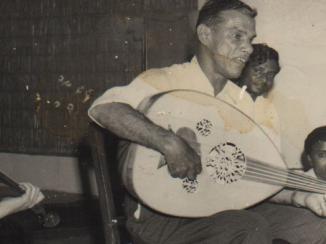‘File 5/191 II Individual slavery cases’
IOR/R/15/1/222
804 items in this record
Search within this record
The record is made up of 1 volume (393 folios). It was created in 2 Aug 1922-17 Dec 1926. It was written in English and Arabic. The original is part of the British Library: India Office The department of the British Government to which the Government of India reported between 1858 and 1947. The successor to the Court of Directors. Records and Private Papers Documents collected in a private capacity. .
About this record
- Content
The volume contains correspondence related to individual cases of the enslavement and trade of Baluchis from the Makran coast and Karachi, to the Trucial and Oman Coast, and in particular to Dubai. The correspondence is predominantly between Government representatives in Karachi/Sind, the Persian Gulf The historical term used to describe the body of water between the Arabian Peninsula and Iran. Political Resident A senior ranking political representative (equivalent to a Consul General) from the diplomatic corps of the Government of India or one of its subordinate provincial governments, in charge of a Political Residency. at Bushire (of which there were three incumbents during the period covered), and the native Residency An office of the East India Company and, later, of the British Raj, established in the provinces and regions considered part of, or under the influence of, British India. Agent at Sharjah, ‘Īsá bin ‘Abd al-Latif. The cases discussed touch upon British attempts to identify and recover Baluchis reportedly taken and transported to the Trucial Coast A name used by Britain from the nineteenth century to 1971 to refer to the present-day United Arab Emirates. , repatriation measures, the terms of punishment for traders/kidnappers, and the expenses incurred at offering protection for recovered slaves.
Of particular interest in the file are reports on the slave trade between Baluchistan and the Gulf, 1923/24 (folios 98-114); correspondence between the native agent Non-British agents affiliated with the British Government. at Sharjah and the Trucial Coast A name used by Britain from the nineteenth century to 1971 to refer to the present-day United Arab Emirates. shaikhs on slave trade (e.g. folios 361-362); and the Hindu community of Dubai’s efforts to take action against the trade of Hindu boys from Karachi (folio 364).
- Extent and format
- 1 volume (393 folios)
- Arrangement
Correspondence, bound roughly in chronological order, from earliest at front of volume to latest at rear.
- Physical characteristics
Foliation: The volume is foliated with circled pencil numbers from the front cover to the last folio, in the top-right corner of each recto The front of a sheet of paper or leaf, often abbreviated to 'r'. . An earlier foliation system uses uncircled pencil numbers, also in the top-right corner of each recto The front of a sheet of paper or leaf, often abbreviated to 'r'. .
Condition: There is some insect damage on the front cover and a small number of folios, but not sufficient to impair legibility.
- Written in
- English and Arabic in Latin and Arabic script
- Type
- Archival file
Archive information for this record
- Original held at
- British Library: India Office The department of the British Government to which the Government of India reported between 1858 and 1947. The successor to the Court of Directors. Records and Private Papers Documents collected in a private capacity.
- Access conditions
Unrestricted
- Archive reference
- IOR/R/15/1/222
- Former external reference(s)
- A Series: 5/191 II
- Date(s)
- 2 Aug 1922-17 Dec 1926 (CE, Gregorian)
- Context of creation
The British Government had long-standing treaties with the Sheikhs of the Trucial Coast A name used by Britain from the nineteenth century to 1971 to refer to the present-day United Arab Emirates. and Muscat dating back to the nineteenth century, promoting the suppression of the maritime slave trade [see Aitchison, Treaties and Engagements Relating to Arabia and the Persian Gulf The historical term used to describe the body of water between the Arabian Peninsula and Iran. , 1987]. Though these treaties had originally been set up to prevent the trade of slaves from Africa, the British Government deemed these treaties equally valid to the increase in the slave trade from the early 1920s from Baluchistan - specifically from both the British and Persian Makran coasts.
The increase in the trade in slaves from Baluchistan to the Arabian Coast was the subject of much debate amongst British Government officials, who blamed political and social instability in the Baluchistan/Makran region - the former supported in the trade of arms from the Arabian Peninsula and the latter caused by ongoing drought conditions and famine - to be sustaining a small, localised slave trade.
Access & Reference
History of this record
Related search terms
Use and share this record
- Share this record
- Cite this record in your research
‘File 5/191 II Individual slavery cases’, British Library: India Office Records and Private Papers, IOR/R/15/1/222, in Qatar Digital Library <https://www.qdl.qa/archive/81055/vdc_100000000193.0x0000c3> [accessed 14 May 2024]
- Link to this record
https://www.qdl.qa/en/archive/81055/vdc_100000000193.0x0000c3
- IIIF details
This record has a IIIF manifest available as follows. If you have a compatible viewer you can drag the icon to load it.https://www.qdl.qa/en/iiif/81055/vdc_100000000193.0x0000c3/manifestOpen in Universal viewerOpen in Mirador viewerMore options for embedding images
Copyright: How to use this content
- Reference
- IOR/R/15/1/222
- Title
- ‘File 5/191 II Individual slavery cases’
- Pages
- 387r:390v
- Author
- Unknown
- Usage terms
- The copyright status is unknown. Please contact copyright@bl.uk with any information you have regarding this item.
- Reference
- IOR/R/15/1/222
- Title
- ‘File 5/191 II Individual slavery cases’
- Pages
- 364r:365v, 372r:372v
- Author
- Kisari, Laloomal Nathamal
- Usage terms
- The copyright status is unknown. Please contact copyright@bl.uk with any information you have regarding this item.
- Reference
- IOR/R/15/1/222
- Title
- ‘File 5/191 II Individual slavery cases’
- Pages
- 364r:365v, 372r:372v
- Author
- Nathuradas, Mohandas
- Usage terms
- The copyright status is unknown. Please contact copyright@bl.uk with any information you have regarding this item.
- Reference
- IOR/R/15/1/222
- Title
- ‘File 5/191 II Individual slavery cases’
- Pages
- 364r:365v, 372r:372v
- Author
- Jethanand, Magoomal
- Usage terms
- The copyright status is unknown. Please contact copyright@bl.uk with any information you have regarding this item.
- Reference
- IOR/R/15/1/222
- Title
- ‘File 5/191 II Individual slavery cases’
- Pages
- 366r:366v, 373r:373v
- Author
- Jadav, Shanker Shamra
- Usage terms
- The copyright status is unknown. Please contact copyright@bl.uk with any information you have regarding this item.
- Reference
- IOR/R/15/1/222
- Title
- ‘File 5/191 II Individual slavery cases’
- Pages
- 288r:288v
- Author
- Said bin Sulaiman bin Muhammad
- Usage terms
- The copyright status is unknown. Please contact copyright@bl.uk with any information you have regarding this item.
- Reference
- IOR/R/15/1/222
- Title
- ‘File 5/191 II Individual slavery cases’
- Pages
- 289r:289v
- Author
- Muhammad bin Ahmed bin Sulaiman
- Usage terms
- The copyright status is unknown. Please contact copyright@bl.uk with any information you have regarding this item.
- Reference
- IOR/R/15/1/222
- Title
- ‘File 5/191 II Individual slavery cases’
- Pages
- 289r:289v
- Author
- Ahmed bin Muhammad bin Sulaiman
- Usage terms
- The copyright status is unknown. Please contact copyright@bl.uk with any information you have regarding this item.
- Reference
- IOR/R/15/1/222
- Title
- ‘File 5/191 II Individual slavery cases’
- Pages
- 291r:291v
- Author
- Shaikhs of Kumazarah
- Usage terms
- The copyright status is unknown. Please contact copyright@bl.uk with any information you have regarding this item.
- Reference
- IOR/R/15/1/222
- Title
- ‘File 5/191 II Individual slavery cases’
- Pages
- 166r:166v
- Author
- Commander of the Muscat Regiment xx Commander of the Muscat Levy Corps xx Commandant, Muscat Infantry
- Usage terms
- The copyright status is unknown. Please contact copyright@bl.uk with any information you have regarding this item.
- Reference
- IOR/R/15/1/222
- Title
- ‘File 5/191 II Individual slavery cases’
- Pages
- 181r:181v, 197r:198v
- Author
- Āl Bū Sa‘īd, Hamad bin Faisal
- Usage terms
- The copyright status is unknown. Please contact copyright@bl.uk with any information you have regarding this item.
- Reference
- IOR/R/15/1/222
- Title
- ‘File 5/191 II Individual slavery cases’
- Pages
- 229r:229v, 231r:232v
- Author
- Āl Qasimī, Shaikh Sultān II bin Saqr
- Usage terms
- Public Domain
- Reference
- IOR/R/15/1/222
- Title
- ‘File 5/191 II Individual slavery cases’
- Pages
- 261r:262v
- Author
- Al Qasimi, Shaikh Saeed bin Hamad
- Usage terms
- Public Domain
- Reference
- IOR/R/15/1/222
- Title
- ‘File 5/191 II Individual slavery cases’
- Pages
- 14r:15v
- Author
- Al Mu'alla, Shaikh Rashid II bin Ahmad
- Usage terms
- Public Domain
- Reference
- IOR/R/15/1/222
- Title
- ‘File 5/191 II Individual slavery cases’
- Pages
- 16r:17v
- Author
- Al Mu'alla, Shaikh Rashid II bin Ahmad
- Usage terms
- Public Domain
- Reference
- IOR/R/15/1/222
- Title
- ‘File 5/191 II Individual slavery cases’
- Pages
- 18r:19v
- Author
- Āl Qāsimī, Shaikh Sulṭān bin Sālim
- Usage terms
- Public Domain
- Reference
- IOR/R/15/1/222
- Title
- ‘File 5/191 II Individual slavery cases’
- Pages
- 20r:21v, 160r:164v
- Author
- Āl Qasimī, Shaikh Khālid bin Aḥmad bin Sultān
- Usage terms
- Public Domain
- Reference
- IOR/R/15/1/222
- Title
- ‘File 5/191 II Individual slavery cases’
- Pages
- 35r:38v, 213r:213v, 220r:222v, 267r:268v, 362r:362v
- Author
- Āl Maktūm, Shaikh Saʻīd bin Maktūm bin Hasher
- Usage terms
- Public Domain
- Reference
- IOR/R/15/1/222
- Title
- ‘File 5/191 II Individual slavery cases’
- Pages
- 70r:70v
- Author
- Karguzar of Bandar Abbas
- Usage terms
- The copyright status is unknown. Please contact copyright@bl.uk with any information you have regarding this item.
- Reference
- IOR/R/15/1/222
- Title
- ‘File 5/191 II Individual slavery cases’
- Pages
- 72r:73v, 83r:83v, 203r:203v
- Author
- Mesopotamia Persia Corporation Limited
- Copyright
- ©Inchcape plc
- Usage terms
- Creative Commons Non-Commercial Licence
- Reference
- IOR/R/15/1/222
- Title
- ‘File 5/191 II Individual slavery cases’
- Pages
- 78r:78v
- Author
- Jasub
- Usage terms
- The copyright status is unknown. Please contact copyright@bl.uk with any information you have regarding this item.
- Reference
- IOR/R/15/1/222
- Title
- ‘File 5/191 II Individual slavery cases’
- Pages
- 86r:86v, 103r:103v, 105r:105v
- Author
- Navarra
- Usage terms
- The copyright status is unknown. Please contact copyright@bl.uk with any information you have regarding this item.
- Reference
- IOR/R/15/1/222
- Title
- ‘File 5/191 II Individual slavery cases’
- Pages
- front , back , spine , spine-a:spine-b, edge , head, tail , front-i, 1ar:1cv, 2r:13v, 22r:34v, 39r:69v, 71r:71v, 74r:77v, 79r:82v, 84r:85v, 87r:102v, 104r:104v, 106r:159v, 165r:165v, 167r:180v, 182r:196v, 199r:202v, 204r:212v, 214r:219v, 223r:228v, 230r:230v, 233r:260v, 263r:266v, 269r:281v, 282ar, 282v:287v, 290r:290v, 292r:361v, 363r:363v, 367r:371v, 374r:386v, 391r:395v, back-i
- Author
- East India Company, the Board of Control, the India Office, or other British Government Department
- Usage terms
- Open Government Licence




































































































































































































































































































































































































































































































































































































































































































































































































































